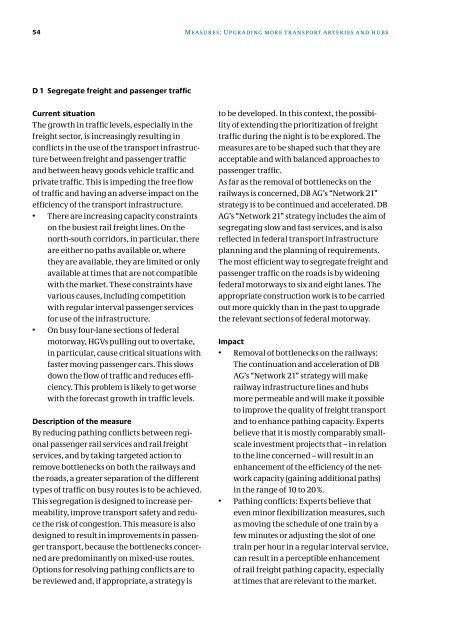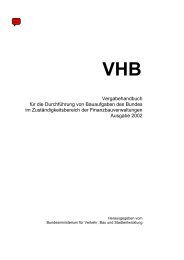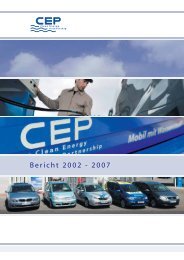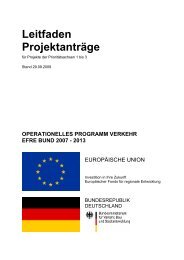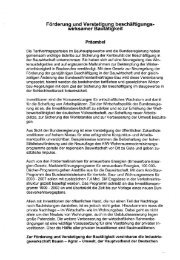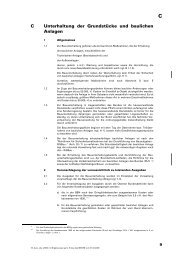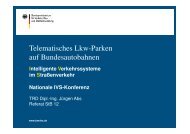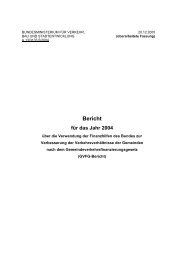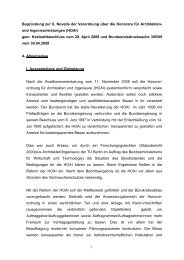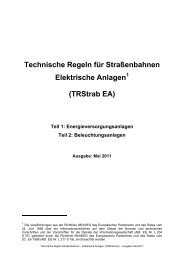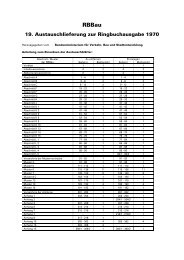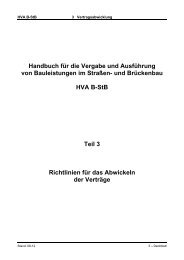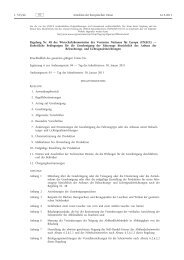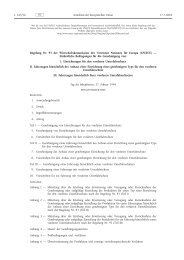Freight Transport and Logistics Masterplan - Bundesministerium für ...
Freight Transport and Logistics Masterplan - Bundesministerium für ...
Freight Transport and Logistics Masterplan - Bundesministerium für ...
Create successful ePaper yourself
Turn your PDF publications into a flip-book with our unique Google optimized e-Paper software.
D 1 Segregate freight <strong>and</strong> passenger traffic<br />
Current situation<br />
The growth in traffic levels, especially in the<br />
freight sector, is increasingly resulting in<br />
conflicts in the use of the transport infrastructure<br />
between freight <strong>and</strong> passenger traffic<br />
<strong>and</strong> between heavy goods vehicle traffic <strong>and</strong><br />
private traffic. This is impeding the free flow<br />
of traffic <strong>and</strong> having an adverse impact on the<br />
efficiency of the transport infrastructure.<br />
• There are increasing capacity constraints<br />
on the busiest rail freight lines. On the<br />
north-south corridors, in particular, there<br />
are either no paths available or, where<br />
they are available, they are limited or only<br />
available at times that are not compatible<br />
with the market. These constraints have<br />
various causes, including competition<br />
with regular interval passenger services<br />
for use of the infrastructure.<br />
• On busy four-lane sections of federal<br />
motorway, HGVs pulling out to overtake,<br />
in particular, cause critical situations with<br />
faster moving passenger cars. This slows<br />
down the flow of traffic <strong>and</strong> reduces efficiency.<br />
This problem is likely to get worse<br />
with the forecast growth in traffic levels.<br />
Description of the measure<br />
By reducing pathing conflicts between regional<br />
passenger rail services <strong>and</strong> rail freight<br />
services, <strong>and</strong> by taking targeted action to<br />
remove bottlenecks on both the railways <strong>and</strong><br />
the roads, a greater separation of the different<br />
types of traffic on busy routes is to be achieved.<br />
This segregation is designed to increase permeability,<br />
improve transport safety <strong>and</strong> reduce<br />
the risk of congestion. This measure is also<br />
designed to result in improvements in passenger<br />
transport, because the bottlenecks concerned<br />
are predominantly on mixed-use routes.<br />
Options for resolving pathing conflicts are to<br />
be reviewed <strong>and</strong>, if appropriate, a strategy is<br />
Measures: Upgr ading more tr ansport arteries <strong>and</strong> hubs Measures: Upgr ading more tr ansport arteries <strong>and</strong> hubs<br />
to be developed. In this context, the possibility<br />
of extending the prioritization of freight<br />
traffic during the night is to be explored. The<br />
measures are to be shaped such that they are<br />
acceptable <strong>and</strong> with balanced approaches to<br />
passenger traffic.<br />
As far as the removal of bottlenecks on the<br />
railways is concerned, DB AG’s “Network 21”<br />
strategy is to be continued <strong>and</strong> accelerated. DB<br />
AG’s “Network 21” strategy includes the aim of<br />
segregating slow <strong>and</strong> fast services, <strong>and</strong> is also<br />
reflected in federal transport infrastructure<br />
planning <strong>and</strong> the planning of requirements.<br />
The most efficient way to segregate freight <strong>and</strong><br />
passenger traffic on the roads is by widening<br />
federal motorways to six <strong>and</strong> eight lanes. The<br />
appropriate construction work is to be carried<br />
out more quickly than in the past to upgrade<br />
the relevant sections of federal motorway.<br />
Impact<br />
• Removal of bottlenecks on the railways:<br />
The continuation <strong>and</strong> acceleration of DB<br />
AG’s “Network 21” strategy will make<br />
railway infrastructure lines <strong>and</strong> hubs<br />
more permeable <strong>and</strong> will make it possible<br />
to improve the quality of freight transport<br />
<strong>and</strong> to enhance pathing capacity. Experts<br />
believe that it is mostly comparably smallscale<br />
investment projects that – in relation<br />
to the line concerned – will result in an<br />
enhancement of the efficiency of the network<br />
capacity (gaining additional paths)<br />
in the range of 10 to 20 %.<br />
• Pathing conflicts: Experts believe that<br />
even minor flexibilization measures, such<br />
as moving the schedule of one train by a<br />
few minutes or adjusting the slot of one<br />
train per hour in a regular interval service,<br />
can result in a perceptible enhancement<br />
of rail freight pathing capacity, especially<br />
at times that are relevant to the market.<br />
• Removal of bottlenecks on the roads:<br />
Widening to six lanes those stretches of federal<br />
motorway that are busy <strong>and</strong> of prime<br />
importance to road haulage will enhance<br />
the capacity of the sections concerned by<br />
up to 50 %. This will make them correspondingly<br />
more permeable for HGVs <strong>and</strong><br />
passenger cars, <strong>and</strong> is absolutely essential<br />
if the forecast growth in levels of both<br />
types of traffic is to be better absorbed. If<br />
bottlenecks are removed on the road, it<br />
will not be necessary to introduce “areawide”<br />
bans on overtaking for heavy goods<br />
vehicles. Implementation of this measure<br />
will reduce the frequency of congestion<br />
<strong>and</strong> accidents <strong>and</strong> thus also the social<br />
costs of transport. In addition, the reduction<br />
in the number of traffic jams <strong>and</strong><br />
accidents will make road haulage services<br />
easier to plan <strong>and</strong> more reliable across the<br />
entire network. This will make the deployment<br />
of resources more efficient, both for<br />
logistics service providers <strong>and</strong> for trade<br />
<strong>and</strong> industry (less capital-tie up for buffer<br />
stock <strong>and</strong> equipment, improved turnaround).<br />
Ultimately, the measure is also<br />
designed to counter an economically inefficient<br />
downsizing of the vehicle fleet: in<br />
order to get round the obstacles that heavy<br />
goods vehicles face, such as bans on overtaking<br />
<strong>and</strong> speed limits, logistics service<br />
providers are, in some cases, operating<br />
smaller, faster vehicles (light vans) rather<br />
than long-distance HGVs on time-sensitive<br />
<strong>and</strong> just-in-time transport markets.<br />
Responsibility<br />
• DB Netz AG is responsible for removing<br />
bottlenecks on the railways.<br />
• The resolution of pathing conflicts, where<br />
this is appropriate <strong>and</strong> possible, is the<br />
responsibility of DB Netz AG in consultation<br />
with the Federal Network Agency <strong>and</strong><br />
with the involvement of railway underta<br />
kings <strong>and</strong> the federal states affected (as<br />
the authorities that order local transport<br />
services).<br />
• The Federal Ministry of <strong>Transport</strong>, Building<br />
<strong>and</strong> Urban Affairs, in consultation<br />
with the federal states, is responsible for<br />
removing bottlenecks on the federal motorways.<br />
Budgetary relevance<br />
The updated financial planning includes significantly<br />
higher levels of investment for the<br />
removal of bottlenecks. In 2009, an additional<br />
€ 1 billion (approx.) will be made available.<br />
EU relevance<br />
These measures are consistent with the freight<br />
transport logistics actions that the EU intends<br />
to take.<br />
Implementation period<br />
These measures are due to be launched immediately.


